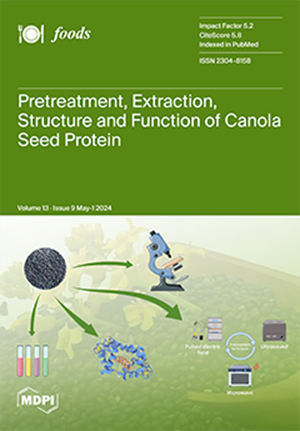The Production of Water Kefir Drink with the Addition of Dried Figs in the Horizontal Rotating Tubular Bioreactor
IF 4.7
2区 农林科学
Q1 FOOD SCIENCE & TECHNOLOGY
引用次数: 0
Abstract
Water kefir is a product obtained through the fermentation of sucrose solution, usually with some kind of dried fruit addition, by a combined culture of micro-organisms which are contained within kefir grains. Its popularity is rising because of the simplicity of its preparation and its anti-inflammatory, antioxidant, probiotic, and antibacterial effects. In this research, the water kefir production was studied in 250 mL jars, as well as in a horizontal rotating tubular bioreactor (HRTB). The first part of the research was conducted in smaller-scale (jars), wherein the optimal fruit and fruit portions were determined. These experiments included the addition of dried plums, apricots, raisins, dates, cranberries, papaya, and figs into 150 mL of initial sugar solution. Also, the optimal ratio between dried fruit and sucrose solution (0.2) at the beginning of the bioprocess was determined. The second part of this research was conducted using HRTB. The experiments in the HRTB were carried out by using different operational modes (constant or interval bioreactor rotation). A total of six different bioreactor setups were used, and in all experiments, figs were added at the beginning of the bioprocess (0.2 ratio between dried figs and sucrose solution). On the basis of the obtained results, the interval bioreactor rotation mode proved to be the better HRTB mode for the production of the water kefir, as the yield of the main fermentation products was higher, and their ratios were the most adequate for the quality of water kefir drink. The optimal results were obtained via HRTB setup 3/57 (3 min rotation, 57 min pause within 1 h) and rotation speed of 3 rpm. Furthermore, it is clear that HRTB has great potential for water kefir production due to the fact that HRTB experiments showed shorter fermentation times (at least five times) than water kefir production in jars.在水平旋转管式生物反应器中生产添加了无花果干的开菲尔水饮料
开菲尔水是一种通过蔗糖溶液发酵获得的产品,通常会添加一些干果,由开菲尔颗粒中的微生物联合培养而成。由于其制作方法简单,而且具有消炎、抗氧化、益生菌和抗菌作用,因此越来越受欢迎。本研究对 250 毫升罐子和水平旋转管式生物反应器(HRTB)中的水酸乳生产进行了研究。研究的第一部分在较小规模(罐子)中进行,确定了最佳的水果和水果比例。这些实验包括在 150 毫升初始糖溶液中加入李子干、杏干、葡萄干、枣干、蔓越莓干、木瓜干和无花果干。此外,还确定了生物工艺开始时果脯与蔗糖溶液的最佳比例(0.2)。研究的第二部分是使用 HRTB 进行的。在 HRTB 中进行的实验采用了不同的操作模式(恒定或间隔生物反应器旋转)。总共使用了六种不同的生物反应器设置,在所有实验中,无花果都是在生物工艺开始时加入的(无花果干和蔗糖溶液的比例为 0.2)。根据获得的结果,间隔生物反应器旋转模式被证明是生产水酸乳的更好的 HRTB 模式,因为主要发酵产物的产量更高,而且它们的比例最适合水酸乳饮料的质量。通过 HRTB 设置 3/57(旋转 3 分钟,1 小时内暂停 57 分钟)和 3 转/分钟的旋转速度,获得了最佳结果。此外,由于 HRTB 实验显示发酵时间比在罐子里生产水酸乳短(至少 5 倍),因此 HRTB 显然具有生产水酸乳的巨大潜力。
本文章由计算机程序翻译,如有差异,请以英文原文为准。
求助全文
约1分钟内获得全文
求助全文
来源期刊

Foods
Immunology and Microbiology-Microbiology
CiteScore
7.40
自引率
15.40%
发文量
3516
审稿时长
15.83 days
期刊介绍:
Foods (ISSN 2304-8158) is an international, peer-reviewed scientific open access journal which provides an advanced forum for studies related to all aspects of food research. It publishes reviews, regular research papers and short communications. Our aim is to encourage scientists, researchers, and other food professionals to publish their experimental and theoretical results in as much detail as possible or share their knowledge with as much readers unlimitedly as possible. There is no restriction on the length of the papers. The full experimental details must be provided so that the results can be reproduced. There are, in addition, unique features of this journal:
manuscripts regarding research proposals and research ideas will be particularly welcomed
electronic files or software regarding the full details of the calculation and experimental procedure, if unable to be published in a normal way, can be deposited as supplementary material
we also accept manuscripts communicating to a broader audience with regard to research projects financed with public funds
 求助内容:
求助内容: 应助结果提醒方式:
应助结果提醒方式:


